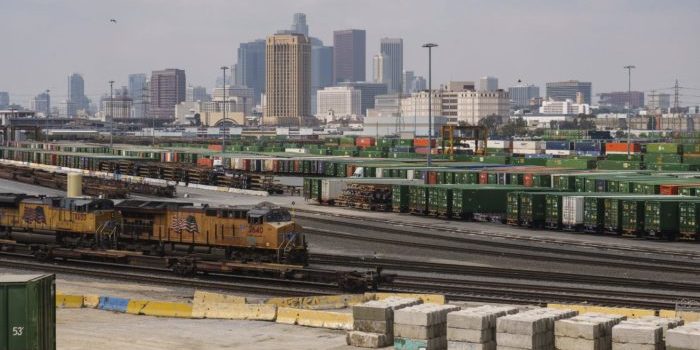(Headline USA) California approved Thursday a first-in-the-nation rule limiting rail pollution to aggressively cut greenhouse gas emissions in the state’s latest move to establish itself as a global leader in the fight against so-called climate change.
The move is likely to have resounding effects that further suppress the economy as many residents and businesses flee the far-left state for those with more freedom and fewer taxes.
The rule will ban locomotive engines more than 23 years old by 2030 and increase the use of zero-emissions technology to transport freight from ports and throughout railyards. It would also ban locomotives in the state from idling longer than 30 minutes if they are equipped with an automatic shutoff.
“It is time to kickstart the next step of transformation, with trains,” said Davina Hurt, a California Air Resources Board member.
But some say it’s too soon for the locomotive standards. Wayne Winegarden, a Pacific Research Institute senior fellow, said the rule would be expensive for rail companies, and increased costs will mean higher prices for many goods that move by rail.
“There is no clear path to zero emissions locomotives,” the Association of American Railroads said in a statement.
“Mandating that result ignores the complexity and interconnected nature of railroad operations and the reality of where zero emission locomotive technology and the supporting infrastructure stand,” the group wrote.
Freight railways are an efficient means to transport the roughly 1.6 billion tons of goods nationwide across nearly 140,000 miles, much cleaner than if those goods were trucked, it said.
The transportation sector contributed the largest share of greenhouse gas emissions nationwide in 2020, according to the Environmental Protection Agency. But rail only accounts for about 2% of those emissions.
Kristen South, a Union Pacific spokesperson, said in a statement the rail company is “deeply disappointed” by the vote, adding that the rule is too ambitious for the current technology and infrastructure.
Union Pacific is working to cut greenhouse gas emissions in part by spending $1 billion to modernize locomotives and testing out engines powered by electric batteries, South wrote.
The standards would need approval from the Biden administration to move forward. They follow rules approved by the EPA to cut emissions from heavy trucks.
Locomotives pull rail cars filled with food, lumber, oil and other products through railyards near neighborhoods in Oakland, Commerce, San Bernardino and other California cities.
They run on diesel, a more powerful fuel than gasoline, producing greenhouse gases and pollution that is harmful for nearby residents.
Other states can sign on to try to adopt the California rule if it gets the OK from the Biden administration.
California has already set out to make big emissions cuts in other areas. The state approved a transition to zero-emissions cars and a roadmap to achieve carbon neutrality, meaning it would remove as many carbon emissions as it releases, by 2045. The board is also considering a rule to electrify a group of heavy trucks that transports goods through ports.
The EPA recently approved California rules requiring zero-emission trucks, depending on the type, to make up between 40% and 75% of sales by 2035.
Some activists would like California to go further, for example, to limit locomotive idling to 15 minutes. They are also concerned that increased demand from online shopping is causing more rail traffic that burdens communities.
Heidi Swillinger lives in a mobile home park in San Pablo, a small city in the San Francisco Bay Area, along the BNSF Railway. She said it’s not uncommon for diesel fumes to fill her house, resulting in a “thick, acrid, dirty smell.”
“Nobody wants to live next to a railroad track,” Swillinger said. “You move next to a railroad track because you don’t have other options.”
Adapted from reporting by the Associated Press

